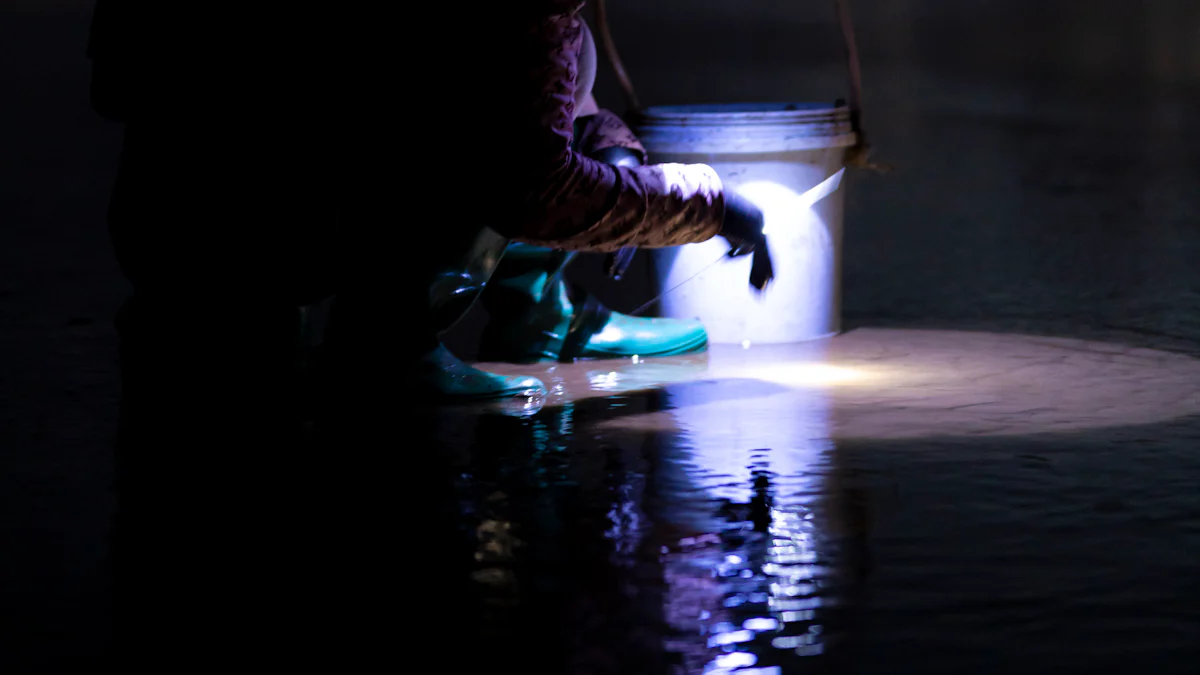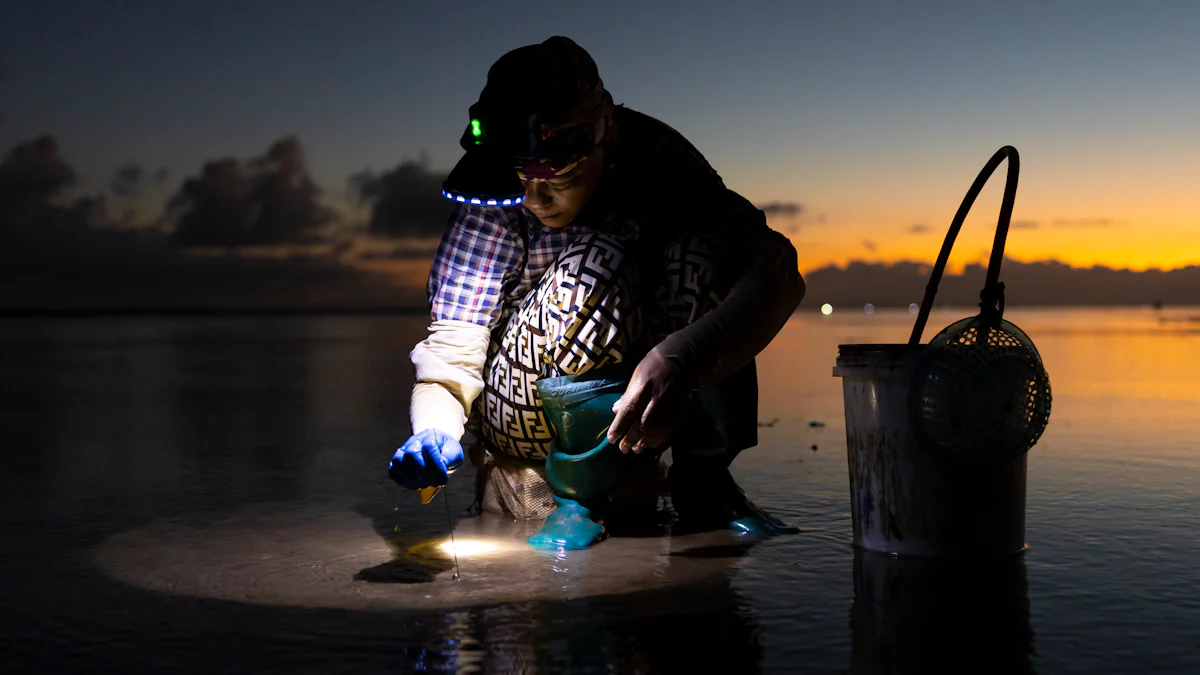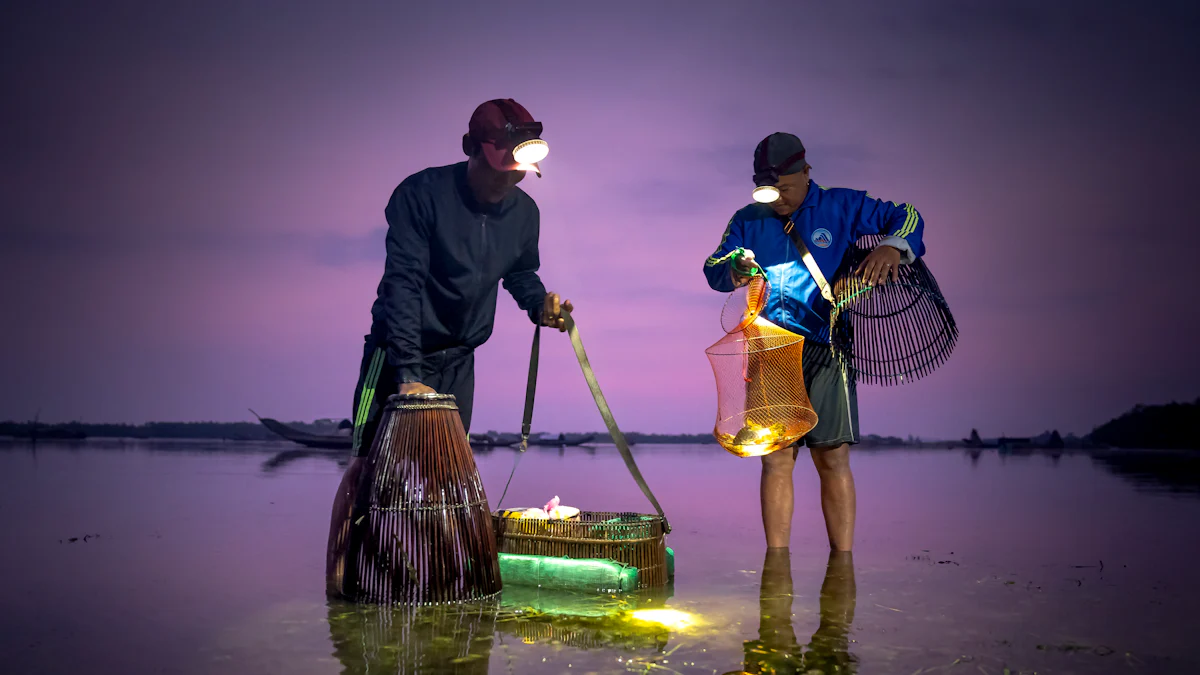Best flashlights for night fishing

Night fishing can be thrilling, but it’s no fun fumbling in the dark. A reliable flashlight is your best friend when you’re tying knots, checking your gear, or spotting fish. The right one keeps you safe and makes your experience smoother. Whether you need a powerful beam or a hands-free option, choosing wisely matters. Some of the best flashlights for fishing include the Noctigon K1 for its incredible brightness and the Princeton Tec FRED, which offers a handy red light mode. With the right flashlight, you’ll never miss a catch in the dark.
Key Takeaways
Pick a flashlight with 200 lumens or more for basic use. For seeing fish, go for 900 lumens or higher.
Get a waterproof flashlight with at least an IPX6 rating. This makes sure it works well in wet places.
Think about battery life and type. Rechargeable batteries save money and are better for the planet.
Check for extra features like red light mode to protect night vision and hands-free options for ease.
Match your flashlight to your fishing spot. A long beam is good for big waters, while a wide beam is better for small areas.
Top flashlights for night fishing

Noctigon K1
Overview
The Noctigon K1 is a powerhouse when it comes to fishing flashlights. It delivers a maximum output of 900 lumens, making it perfect for spotting fish or navigating dark waters. Its narrow spot beam with a dim spill ensures you get a focused light where you need it most. Built with aircraft-grade aluminum, this flashlight is tough enough to handle harsh conditions. Plus, it’s waterproof and dustproof to the IP67 standard, so you don’t have to worry about splashes or rain during your nighttime fishing adventures.
Pros
High lumen output (900 lumens) for excellent visibility.
Durable construction that withstands rough handling.
Waterproof design ensures reliability in wet conditions.
Focused beam intensity (650,000 cd) for long-distance illumination.
Cons
The narrow beam may not be ideal for wide-area lighting.
Slightly heavier than other fishing flashlight options.
Princeton Tec FRED
Overview
If you’re looking for a lightweight and versatile fishing flashlight, the Princeton Tec FRED is a great choice. It offers four light modes, including white and red, which is perfect for preserving your night vision. With a maximum output of 200 lumens and a runtime of up to 41 hours, this flashlight is reliable for extended fishing trips. Its IPX4 water resistance ensures it can handle light splashes, and the asymmetrical bracket rotates 180° for optimal visibility.
Pros
Lightweight design (78g) makes it easy to carry.
Multiple light modes, including red, for added versatility.
Long battery life (up to 41 hours).
Water-resistant to IPX4, suitable for light rain or splashes.
Cons
Limited brightness compared to other flashlights.
Shorter beam distance (21 meters) may not suit all fishing environments.
Fenix HM65R-T
Overview
The Fenix HM65R-T is a headlamp-style fishing flashlight that combines comfort and performance. It features both cool white and warm white beams, offering a mix of flood and throw lighting. With a built-in USB-C charging port and a 3400mAh battery, it’s ready for long fishing sessions. The flashlight is lightweight and designed for hands-free use, making it ideal for tying knots or handling gear.
Pros
Lightweight and comfortable for extended wear.
Dual beams provide a balanced mix of flood and throw.
Long runtimes and USB-C charging for convenience.
Durable design with a 3400mAh battery included.
Cons
Low voltage warning can be hard to notice.
The shroud on the switches may make them harder to access.
Olight Seeker 3 Pro
Overview
The Olight Seeker 3 Pro is a versatile flashlight that packs a punch. It delivers an impressive 4,200 lumens, making it one of the brightest options for nighttime fishing. Whether you’re scanning the water or organizing your gear, this flashlight ensures you won’t miss a thing. Its compact design fits comfortably in your hand, and the rotary knob lets you adjust brightness levels with ease. The Seeker 3 Pro is also waterproof with an IPX8 rating, so it can handle being submerged in water. Plus, the built-in rechargeable battery saves you from constantly buying replacements.
Pros
Outstanding brightness (4,200 lumens) for maximum visibility.
Compact and ergonomic design for easy handling.
Waterproof (IPX8) for reliable use in wet conditions.
Rechargeable battery with a magnetic charging cable.
Smart proximity sensor to prevent overheating.
Cons
Higher price point compared to other fishing flashlight options.
May feel too bright for close-up tasks.
Streamlight 88065 ProTac HL-X
Overview
The Streamlight 88065 ProTac HL-X is a rugged flashlight built for tough environments. It offers a maximum output of 1,000 lumens, providing plenty of light for nighttime fishing. Its durable aluminum body can withstand drops and rough handling, making it a reliable companion on your fishing trips. This flashlight is also waterproof with an IPX7 rating, so it’s ready for rain or accidental splashes. You can power it with either a rechargeable battery or CR123A batteries, giving you flexibility based on your needs.
Pros
Durable construction for long-lasting performance.
Dual power options (rechargeable or disposable batteries).
Waterproof (IPX7) for added reliability.
High lumen output (1,000 lumens) for excellent visibility.
Compact size for easy portability.
Cons
Shorter runtime on the highest brightness setting.
Lacks additional light modes like red light.
Key features to look for in a night fishing flashlight

When you're choosing a flashlight for nighttime fishing, you want to make sure it checks all the right boxes. Let’s break down the key features that matter most.
Brightness and lumens
The brightness of a flashlight is measured in lumens, and this determines how much light it can produce. For night fishing, you’ll want a flashlight that’s bright enough to illuminate your surroundings without being blinding. A flashlight like the Noctigon K1, for example, offers 900 lumens and an impressive throw distance of nearly a mile. That’s well above industry standards and perfect for spotting fish or navigating dark waters.
Here’s a quick comparison to give you an idea:
Feature | Noctigon K1 | Industry Standard |
|---|---|---|
Peak Beam Intensity | 685 cd/lm | Varies (lower) |
Maximum Output | 900 lumens | Varies (lower) |
Throw Distance |
| Varies (lower) |
If you’re fishing in smaller areas or close to shore, you might not need extreme brightness. But for open waters, a high-lumen flashlight is a game-changer.
Battery life and power source
Long fishing trips demand a flashlight with reliable battery life. You don’t want your light dying in the middle of the night! Most flashlights offer multiple modes, so you can adjust the brightness to extend runtime. For instance:
Mode | Lumens | Runtime |
|---|---|---|
Low | 20 | 40 hours |
Medium | 500 | 4 hours |
High | 1000 | 2 hours |
Rechargeable batteries are a fantastic option for night fishing. They’re convenient, cost-effective, and environmentally friendly. You can charge them anywhere with a USB port, which is super handy when you’re out on the water. Plus, they provide more power for high-drain flashlights, ensuring brighter and longer-lasting light.
Waterproof and durability
Fishing means dealing with water, so a waterproof flashlight is non-negotiable. Look for an IP rating to understand how much water exposure your flashlight can handle. For night fishing, an IPX6 or higher is ideal. Here’s a quick guide:
IP Rating | Description |
|---|---|
IPX4 | Protection against splashing water. |
IPX6 | Withstands strong water jets and waves. |
IPX7 | Can be submerged in water up to 1 meter. |
IPX8 | Suitable for continuous submersion. |
An IPX6-rated flashlight can handle rain or accidental splashes, while an IPX8-rated one is perfect if you’re fishing in rough conditions or near deep water. Durability is just as important. A sturdy flashlight with impact resistance will survive drops or bumps, which are pretty common during nighttime fishing adventures.
Pro Tip: Always check the flashlight’s build quality. Aluminum bodies are lightweight yet tough, making them a great choice for fishing flashlights.
Beam distance and focus
When you're out fishing at night, the beam distance of your flashlight can make or break your experience. A flashlight with a long beam distance helps you spot fish, navigate tricky terrain, or even locate your boat in the dark. Ideally, you want a beam distance of around 300 meters (328.1 yards). This range is perfect for nighttime fishing, as it provides enough reach without overwhelming your surroundings. For example, the LA Gear Recon Rechargeable Flashlight offers a powerful 1000-lumen light with this exact beam throw, making it a reliable choice for anglers.
But beam distance isn’t the only thing to consider. Focus matters too. Some flashlights let you adjust the beam from a wide floodlight to a narrow spotlight. A wide beam is great for illuminating your immediate area, like when you're tying knots or organizing gear. On the other hand, a focused beam is better for long-distance spotting. Look for a flashlight that offers both options, so you can switch depending on your needs.
Pro Tip: If you’re fishing in open waters, prioritize a flashlight with a longer beam distance. For smaller, enclosed areas, a wide beam will serve you better.
Portability and weight
You don’t want to lug around a heavy flashlight while fishing. Portability is key, especially if you’re carrying other gear. Lightweight flashlights are easier to handle and won’t weigh you down during long trips. Here’s a quick look at the weight ranges of different types of fishing flashlights:
Flashlight Type | Weight (oz) | Weight (g) |
|---|---|---|
Spotlight | 24 oz | 685 g |
Headlight | 5.3 oz | 150 g |
HT18 | 7.76 oz | 220 g |
Headlamps are particularly handy because they’re lightweight and keep your hands free. They’re perfect for tasks like baiting hooks or untangling lines. If you prefer handheld flashlights, go for compact models that fit comfortably in your hand. Just make sure they’re waterproof and durable enough to handle the demands of nighttime fishing.
Note: Always balance weight with functionality. A slightly heavier flashlight with better features might be worth the trade-off.
How to choose the right flashlight for your needs
Assessing your fishing environment
Your fishing environment plays a big role in choosing the right flashlight. Are you fishing in open waters or near the shore? For open waters, you’ll need a flashlight with a long beam distance to spot fish or navigate effectively. A narrow beam with high intensity works best in these situations. On the other hand, if you’re fishing in smaller, enclosed areas, a wide floodlight will help you see your immediate surroundings better.
Durability is another factor to consider. Look for flashlights made from tough materials like aircraft-grade aluminum or stainless steel. These materials can handle rough conditions and last longer. Since water is always nearby when fishing, a waterproof flashlight is essential. Choose one with a high IPX rating, like IPX8, to ensure it can handle splashes or even full submersion.
Tip: A waterproof flashlight isn’t just a luxury—it’s a necessity. Even minor splashes can damage non-waterproof models, leaving you in the dark.
Considering your budget
Flashlights for night fishing come in a wide price range. High-quality options like the P7R Signature can cost around €175.00, but you don’t always need to spend that much. Set a budget that works for you and focus on the features you need most. If you’re fishing occasionally, a mid-range flashlight with decent brightness and waterproofing might be enough. For frequent anglers, investing in a premium model with advanced features could save you money in the long run.
Note: While it’s tempting to go for the cheapest option, remember that a reliable flashlight is an investment. A poorly made flashlight might fail when you need it most.
Evaluating additional features (e.g., red light mode, hands-free options)
Extra features can make your fishing experience much smoother. A red light mode, for example, is less disruptive to fish than white light. It helps you attract fish without scaring them away. If you’re serious about night fishing, this feature is a game-changer.
Hands-free options like headlamps are another great addition. They let you focus on tasks like baiting hooks or casting lines without juggling a flashlight. Some headlamps, like the Adaptev Headlamp, even adjust their beam direction with your head movements. This ensures you always have light where you need it. You can also attach them to surfaces or wear them for added convenience.
Pro Tip: If you’re multitasking during your fishing trips, a headlamp can be your best friend. It keeps your hands free and your focus sharp.
Comparing rechargeable vs. disposable batteries
When it comes to powering your night fishing flashlight, you’ve got two main options: rechargeable or disposable batteries. Each has its perks and drawbacks, so let’s break it down to help you decide which works best for your needs.
Rechargeable batteries are a popular choice for many anglers. They’re powerful, cost-effective in the long run, and better for the environment. These batteries can handle high-drain devices like flashlights, providing consistent power throughout your fishing trip. Plus, you won’t have to keep buying replacements, which saves money over time. However, they do come with a few downsides. Rechargeable batteries can be pricey upfront, and some models are bulkier than their disposable counterparts. You’ll also need to charge them, which might be inconvenient if you’re out on the water for extended periods without access to power.
Here’s a quick comparison to make things clearer:
Pros of Rechargeable Batteries | Cons of Rechargeable Batteries |
|---|---|
Higher power capacity for high-drain devices like flashlights | Can be more expensive upfront than AA batteries |
Low inner resistance for constant power flow | Some models can be bulky |
Long-term cost savings compared to single-use batteries | Requires charging, which can be inconvenient during power outages |
More eco-friendly due to longer lifespan | Potential for leakage if not used frequently |
On the other hand, disposable batteries are all about convenience. You can grab them almost anywhere, and they’re ready to go right out of the package. They’re lightweight and perfect for short fishing trips or as a backup option. But they don’t last as long, especially in high-powered flashlights. Over time, the cost of replacing them can add up, and they’re not the most eco-friendly choice.
So, which should you choose? If you’re a frequent night angler, rechargeable batteries are a smart investment. They’ll save you money and reduce waste. But if you’re fishing occasionally or need a backup, disposable batteries might be the way to go. It all depends on your fishing habits and how much convenience matters to you.
Tip: Always carry a spare set of batteries, whether rechargeable or disposable. You never know when you’ll need them!
Choosing the right flashlight can make or break your night fishing experience. Among the top picks, the Noctigon K1 and Princeton Tec FRED stand out for their unique features. Here’s a quick comparison to help you decide:
Feature | Noctigon K1 | Princeton Tec FRED |
|---|---|---|
Lumen Output | Up to 1400lm | 200lm |
Weight | 316g (385g w/ battery) | 78g |
Waterproof Rating | IP67 | IPX4 |
Battery Type | 21700 or 18650 | 3 AAA Alkaline |
Modes | Ramping interface | 4 modes (high/low white and red) |
The Noctigon K1 offers incredible brightness, a durable build, and advanced controls, making it perfect for open waters. Meanwhile, the Princeton Tec FRED is lightweight, versatile, and ideal for preserving night vision with its red light mode.
When picking your flashlight, focus on features that match your fishing style. Look for brightness, water resistance, and long battery life. A red light mode can also be a game-changer for attracting fish.
Final Tip: Always prioritize what matters most to you. Whether it’s waterproofing, portability, or runtime, the right flashlight will keep you prepared for any nighttime adventure.
FAQ
What flashlight brightness is best for night fishing?
You’ll want a flashlight with at least 200 lumens for general tasks. For spotting fish or navigating open waters, aim for 900 lumens or more. Brightness depends on your environment, so choose a flashlight that fits your fishing style.
Are headlamps better than handheld flashlights for fishing?
Headlamps are great for hands-free tasks like tying knots or baiting hooks. They’re lightweight and keep your hands free. Handheld flashlights, however, offer more power and beam control. Pick what suits your needs best.
How do I maintain my fishing flashlight?
Rinse it with fresh water after exposure to saltwater. Dry it thoroughly before storing. Check the battery regularly and recharge or replace it as needed. Proper care ensures your flashlight lasts longer.
Is a red light mode necessary for night fishing?
Red light mode isn’t essential, but it’s helpful. It preserves your night vision and doesn’t scare fish away. If you fish often at night, a flashlight with this feature can make a big difference.
Can I use a regular flashlight for night fishing?
You can, but it might not perform well. Regular flashlights often lack waterproofing, durability, and long battery life. A fishing-specific flashlight is designed to handle wet conditions and extended use, making it a better choice.
Tip: Always carry a backup flashlight or extra batteries. You never know when you’ll need them!
See Also
Experience Night Fishing Hands-Free With A Headlamp
Brighten Your Outdoor Adventures With The SF1 Flashlight
Why Hunting Flashlights Are Crucial For Outdoor Lovers
Guidelines For Selecting The Perfect Camping Flashlight
Comprehensive Guide To Selecting Flashlights For Backcountry Hiking
